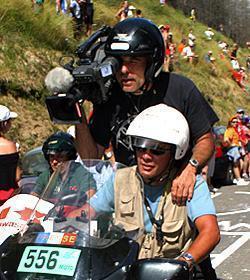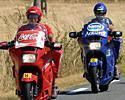
| Tour home |
| Preview |
| Photos |
| Live coverage |
| Start list |
| Stages & results |
| News |
| Map & profiles |
| Tour diaries |
| Features & tech |
| FAQ |
| Tour history |
Recently on Cyclingnews.com |
90th Tour de France - July 5-27, 2003
Riding the Moto Presse Ecrit
Le Tour's TV cameramen and a select few photographers spend each stage aboard a motorbike, and get to see all the action. For a Tour wordsmith, a ride on the press motorbike is a rare chance to see the race up close - and get scared silly in the process, as moto newbie Jeff Jones discovered.
 |
For a journalist sitting in a car, the Tour de France is a difficult race to cover due to the massive convoy both behind and in front. If you want to actually see the riders from a car, you practically have to be sitting with Jean-Marie Leblanc in his Alfa Romeo, score a ride in a VIP or team car, or work for France Télévisions. Perhaps the best seat in the house is on one of the numerous motorbikes in the race, a mixture of TV, radio and photographers, who are allowed much closer access to the riders.
The Tour organisation realises this size problem, and does its best to give journalists access to the race, without overcrowding the already gigantic convoy. Each stage, a journalist from the written press is given the opportunity to ride on the "Moto Presse Ecrit" - a specially designated motorbike often piloted by the impressive Thierry Bouton, a solidly-built, Marlboro-smoking guy who runs a bar in northern France for most of the year, but also does a lot of Sociètè du Tour de France races on the side.
I had the opportunity to take a Moto Presse Ecrit ride on Stage 13 between Toulouse and Ax 3 Domaines, and got the 'ride of my life', as many journalists have done before me. I admit it was also my first time on a motorbike, a factor that I didn't consider until we got on the road. Thierry's Kawasaki is 1200cc, and it is capable of higher speeds than I care to contemplate. It also has good brakes, which were effective in reducing the aforementioned speeds to almost zero in a matter of seconds. This was useful. Especially if you like to drive like Thierry.
After the stage started, we decided to head out to a point about 30 km from Toulouse to stop and have a sandwich, a smoke and a chat with a couple of the other moto guys. One drove a red Coca-Cola bike, and the other a blue Aquarel bike, and they are responsible for giving the riders "neutral bottles" during the stage without needing their team car. The long, wide, tree lined roads out of Toulouse gave Thierry and his pals a chance to demonstrate some of the power of their machines, and I realised how different 160 km/h is on a motorbike compared to a car.
 |
By the time we stopped, a 10-man breakaway had escaped and already had two minutes on the peloton. This was a good opportunity for us to drop in behind the break and see some of the action. While we waited and Thierry made inroads on his bottomless packet of Marlboros, several people asked us where Richard Virenque was. "Dans le peloton," was the reply, and we found ourselves giving the same answer whenever we stopped during the course of the stage. The public in France are still mad for 'Allez Richard', who will almost certainly take his sixth polka dot climber's jersey in the Tour.
I was quite happy to sit behind the break, and it provided a great opportunity to see how the media works in the race. It's essentially a rotating paceline of motorbikes and cars, all of which take turns in going right up behind the riders to do their jobs. Seeing as there were 10 teams represented, there were also 10 team cars, with US Postal-Berry Floor having the front position for most of the time, unless other riders signaled for their cars. It looks and is quite chaotic, but it's all controlled by a traffic moto who signals when its your turn to go to the front.
This didn't always seem to apply to my pilot Thierry, who liked to drop back behind the convoy and then zig-zag his way up the centre at high speed, making limited use of the brakes and raising my adrenaline levels somewhat. It kept me alert on what was a very hot and tiring day (over five hours in the saddle). And of course it gave me the perfect position to watch the dynamics of the breakaway: US Postal's rider - Jose Luis Rubiera - was not doing any work in the break, as is normal when the team leader is in yellow. The others were swapping off fairly evenly, despite the fact that they were giving Rubiera an armchair ride to the final two climbs.
The big Norwegian, Thor Hushovd was quite impressive, with his powerful sprint giving him both of the intermediate bonus sprints en route. In case you're wondering, yes the TV camera bikes do get that close to the riders, giving them a bit of a draft as well as some exhaust fumes.
The heat was baking, and we continued to stop for some relief on the side of the road, although perhaps not in the same manner as Jan Ullrich during the stage. Just after the second sprint, Thierry spotted a couple he knew and screeched to a halt again. He enjoyed another smoke and a brief chat before we decided to get going again, as the peloton was approaching behind.
Due to the fact we had a closed road and a skilled driver, we quickly caught the riders as they were climbing the Col du Portel, a steady (but uncategorised) climb that took them up to 620m before quickly plunging down into Quillan at 340m. Although the descent was fairly short, the riders were taking it as fast as possible, and that meant we were too. Ooh-la-la! Now my (relative nonexistent) motorbike skills were tested to the maximum as we hurtled down and around the hairpins, overtaking everyone in front of us until we ended up next to the race director's Alfa, which was squealing its tyres around every corner and I felt sure was going to lose it at any moment.
I knew I had to relax and lean with my pilot into the corners, but the g-forces when we accelerated and then suddenly slowed down into the hairpins were nothing like I'd ever experienced. I realised I should never have chickened out of all those fun park rides as a child, as it's the only thing close to something like this... but nothing like as dangerous.
We survived intact, but by the bottom I was shaking as we zoomed past the break for another stop before the big climb of the day, the Port de Pailheres. As he opened the pack of Marlboros and handed me another bottle of water, Thierry calmly explained to me how I should descend: gently, moving the eyes in synch with him, and we'd be okay. Despite his sagely advice, I wasn't particularly looking forward to the 18 km descent off the Pailheres!
The climb however was fantastic. We caught and passed the break again at the bottom, then stopped off at a number of points on the way up where we could see the peloton catching the break, which had exploded when Rubiera powered away. We also watched Carlos Sastre and Francisco Mancebo attack the bunch, and they eventually caught Rubiera at the top. And still, the most frequently asked question to us when we halted was "Ou est Richard?". By that stage, we didn't really know, and the spectators would find out soon enough anyway.
We opted to stay in front of the "bagarre" that was happening behind us, much to my relief, and Thierry powered up the Kawasaki one more time before the summit of the Port de Pailheres. The roads were incredibly narrow and twisty, but we could always find a gap between the cars and the thousands of fans as we crested. Strangely enough, the roads on the other side of the climb were much better - plenty of corners but generally wide enough to overtake on the hairpins, much to Thierry's delight.
After my harrowing experience earlier, this descent turned out to be far better, as using my available mental fortitude I tried to follow monsieur Bouton's advice. It was still too hard to relax, and my forearms were stiff from the decelerations, but it was exhilarating this time rather than being terrifying. A few kilometres from the bottom we caught the Coca Cola bike again, and he and Thierry engaged in a "fun" pursuit match right down into Ax-les-Thermes. We finally reached the bottom and slowed down to a breakneck speed, rather than something considerably quicker. I have gained a lot of respect now for the TV moto riders, who do these descents standing up all the way behind their pilots.
A short way up the final 9 km ascent to the Plateau de Bonascre, we stopped by a roadside kiosk that was serving drinks, and I bought Thierry and myself a well-deserved (but small, don't want take any more risks) beer. I wish we'd had it earlier, as he was definitely calmer after that! He also seemed to have an inexhaustible supply of cigarettes. Doesn't nicotine make you nervous or something?
We could hear on the radio that the race was really coming alive behind us, with Carlos Sastre starting the final climb with a few minutes lead on the groupe maillot jaune. We had to remain in front, as I wanted to get to the finish before it ended, but we could still stop a couple more times to see the action and enjoy the throngs of orange clad Basque fans who were hoping for a Euskaltel (or other Basque) victory today. [Sastre's win and Zubeldia's third would suffice, even though Sastre is not Basque.]. As we were not far in front of the race, I now have a fair idea of what it's like to ride though those tunnels of mad fans: an unforgettable experience.
My day on the bike finally came to an end when the excellent Thierry Bouton dropped me off right at the press room, just in time for me to see Ullrich and Zubeldia distance Lance Armstrong near the top of the climb at the end of yet another great stage. Merci bien Thierry, and maybe see you again next year.
|
